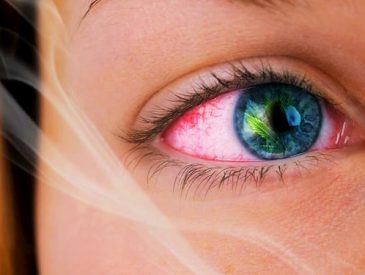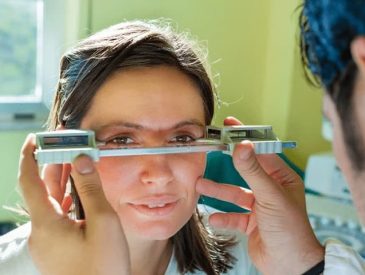A stye is a painful red bump on your eyelid edge. A stye develops when a tiny oil gland close to the eyelashes becomes clogged and infected, much like an acne pimple does. Most often, you can treat a stye at home because they are so common. However, some cases may require treatment by an eye care provider.
Your upper or lower eyelid may have a stye if you notice a bump or pimple there. An infection has spread to the oil glands near the eyelids.
No need to be concerned about infecting someone else with a stye. It isn’t contagious.
Table of Contents
What is a Stye?
A painful red bump on the edge of your eyelid is called a stye (sometimes spelled sty). It might resemble an acne pimple. When a tiny oil-producing gland in your eyelid skin or eyelash follicle becomes obstructed and infected, it develops into a stye. Hordeolum is the medical term for a stye.
There are two types of styes:
- External styes.These form on the outer part of either the upper or lower eyelid. The most typical kind of styes, external styes, are typically brought on by an infection in the follicles of your eyelashes.
- Internal styes. Your inner eyelids, which are facing your eyeball, are where they develop. The inner eyelid gland, which produces oils that help keep your eyelids moist, is typically where an internal stye develops.
A chalazion, another bump on the eyelid, resembles a stye. A bump called a chalazion typically appears further back on your eyelid. A chalazion is not typically painful, unlike a stye, and it is not brought on by a bacterial infection. However, the two conditions are treated similarly.
Styes are frequently found on just one eyelid, but they can also appear on both lids.
How Common is a Stye?
Styes are very common and occur equally in all races and genders. However, styes may affect adults more frequently than kids simply because adults’ oil glands produce thicker oil than kids’ do. This indicates that blockage is more likely.
You run a higher risk of getting a stye if you have certain conditions like blepharitis, dandruff, rosacea, diabetes, or high levels of bad cholesterol. A stye will typically disappear on its own after a few weeks. For advice, speak with an eye care specialist if it doesn’t naturally dissolve after the second week.
Read about What is the Colored Part of the Eye Called?
Who is at Risk?
Styes can develop at any age, but they are more frequently seen in children than in adults. Additionally, if you’ve ever had a stye, your risk is higher.
You’re also at risk of styes if you have blepharitis. A chronic condition called blepharitis causes the eyelid to become inflamed because oil glands close to the base of the eyelashes are blocked.
Diabetes and rosacea are two additional conditions that could make you more likely to develop a stye. Your skin may develop red patches if you have rosacea.
You could be at risk if you come into contact with someone who has a stye or share a towel or pillowcase with them, but this is uncommon.
Causes of Stye
Styes are primarily brought on by bacteria, most frequently the staphylococcus species. If bacteria infect an oil gland, you get an “internal stye.” When you get an infection on your eyelash follicle, it’s called an “external stye.”
An infection-causing bacteria can enter an area after a cut or other type of injury. Or you could just frequently touch or rub your eyes with germ-laden hands. Your eyes might scratch more frequently during allergy season.

Symptoms: How to Identify a Stye?
A small, painful, red lump appears at the base of your eyelash when you have an external stye. A tiny pus spot that resembles a pimple may develop at the tip of a stye due to infection. Your eye may become itchy and painful as a result. It might also be watery, crusty, and more light-sensitive. Your entire eyelid may swell in some circumstances.
Even though it is still red and uncomfortable, an internal stye may not initially be as obvious. But over time, it might obstruct a gland, causing oil to build up in a lump on your eyelid that medical professionals refer to as a chalazion. Unless it becomes quite large, the bump itself doesn’t hurt much. Then it might even press on your eyeball and blur your vision. Check for What Is Normal Eye Pressure?
Treatment of Stye
Focusing on getting rid of this as soon as possible is probably the best way to make sure that a stye doesn’t return or that you don’t spread it to other people. There are fortunately many different possible treatments.
Home Remedies
Styes frequently go away on their own, but there are some simple home remedies you can try that may hasten the process. You may want to try the following:
- Warm washcloths should be placed over the sty for up to 15 minutes, three to five times per day.
- Gently rub the afflicted lid.
- Rub on lid scrubsfrom the over-the-counter aisle of your drugstore or gently wipe the area with a no-tears option such as the Johnson’s Baby Shampoo.
Medical Intervention
If the stye doesn’t go away on its own within a week, consult a healthcare provider. Your practitioner will likely:
- Give a prescription for a topical antibiotic ointment, drops, or perhaps pills.
- Reduce swelling by injecting a steroid.
- To surgically drain the stye (an office procedure), make an incision.
- Close to the stye, remove an eyelash.
Additionally, avoid popping this on your own to ensure that the stye heals quickly. One possibility is that instead of a stye, this might be a chalazion.7 Additionally, you run the risk of accidentally spreading the infection by squeezing it into the tissue around it.
Do not attempt to pop a stye on your own. One possibility is that this is a chalazion rather than a stye. Additionally, you run the risk of accidentally spreading the infection by squeezing it into nearby tissue.
Tips for Preventing a Stye
Hands frequently carry dirt and germs that can infect or clog pores or hair follicles close to your eye and cause a stye. Cleaning your hands is essential. Use hand sanitizers that contain alcohol to keep them clean, or just plain soap and warm water.
Take care not to touch your eyes. When your eyes itch, it can be tempting to rub them, especially during allergy season. Try to resist it and consider allergy medication if it helps with the itch.
In order to prevent pores and hair follicles from being clogged by makeup, wash it off each night before bed. In order to avoid bacteria, it’s also a good idea to discard makeup after about 6 months and avoid sharing it with others.
If you already have a stye, try to avoid wearing contact lenses. Ask your doctor how to clean and disinfect them the most effectively. prior to handling them, thoroughly wash your hands.
Can Styes Ever Be Contagious?
Styes technically can be contagious if someone with one touches it and then spreads the bacteria from their finger to another person (or even to their other eye), but this rarely happens.
You cannot get a stye from simply being around someone who has one because styes are not spreadable through casual contact. Because bacteria are what causes styes to form, touching, squeezing, or scratching a stye spreads that bacteria to your fingers or whatever object you used to touch the stye.
For example, bacteria can spread if a person touches their stye but doesn’t wash their hands before touching a common surface — such as a doorknob, elevator button or office coffee maker — then someone else touches that surface, and then their eyes, before washing their hands.
Similarly, if someone with a stye uses a towel on their face and you use the same towel on your face, stye-causing bacteria may come into contact with your eyes.
This risk affects more than just the individual. Wearing eye makeup while you have a stye increases your risk of infecting both eyes or developing multiple styes on one eye because you can spread the bacteria to other oil glands and eyelash follicles.
A Word from Verywell
The majority of sties are localized and disappear quickly on their own. However, make sure to let your healthcare provider know if a stye appears to be lingering or spreading. Although styes rarely worsen, they should be checked out right away if they do.
Read about





